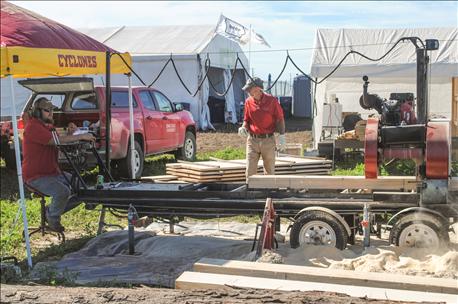
As the weather cools down, fall is a time when landowners often take to the woods to cut up downed trees or mill logs into usable lumber. According to the U.S. Department of Labor Occupational Safety and Health Administration, operating a sawmill is one of the most dangerous jobs in the country. Massive weights of logs being milled combined with the nature of sawmill equipment can cause lacerations, severed fingers and blindness. Exposure to sawdust can cause respiratory illnesses as well.

HOW TO DO IT: ISU Extension forestry division personnel demonstrated safe operations of a portable sawmill at this year’s Farm Progress Show in Boone, Iowa.
Portable sawmill operators often set up the mill in the woods, miles from any health care or emergency facilities. Mills are sometimes placed on uneven or unstable terrain in the woodlands, and they are often operated under less-than-ideal environmental conditions and weather. Footing around the mill may also be unstable, with holes in the ground, and sawdust and mill waste, or small branches, rocks and sticks protruding under the feet of the operator.
With these concerns in mind, we caught up with Iowa State University Extension forester Jesse Randall at the Farm Progress Show near Boone, Iowa, and asked him about safe operations of portable sawmills. He shared three basic tips that serve as a good primer on sawmill safety.
• Protect eyes, ears and lungs. “Protect your hearing and your eyes,” Randall says. In other words, wear ear plugs or a headset to protect your ears, and wear protective eyeglasses or eye gear to protect your eyes. “Protect yourself from dust by wearing a dust mask,” he adds.
• Shut the machine down. If you have to do maintenance or repairs on the mill, be sure to shut everything down, Randall says. “Even if you are just working with a log, move the band saw to the other end of the rig to make sure you don’t accidentally fall into it,” he says. Most portable mills now have hydraulic capabilities to help load logs, so that saves on strain on the back of the operator, says Randall.
• Stay out of the sawdust. “Stay downwind, away from where the sawdust is landing,” he says. “Keep as far away from the sawdust as possible for safety reasons.”
Randall says the biggest tip for safety is to take your time and slow down. Accidents happen when mill operators get in a hurry around a multitude of sharp, multiple moving parts.
You can learn more about safe sawmill operation by contacting Randall at [email protected].
About the Author(s)
You May Also Like






